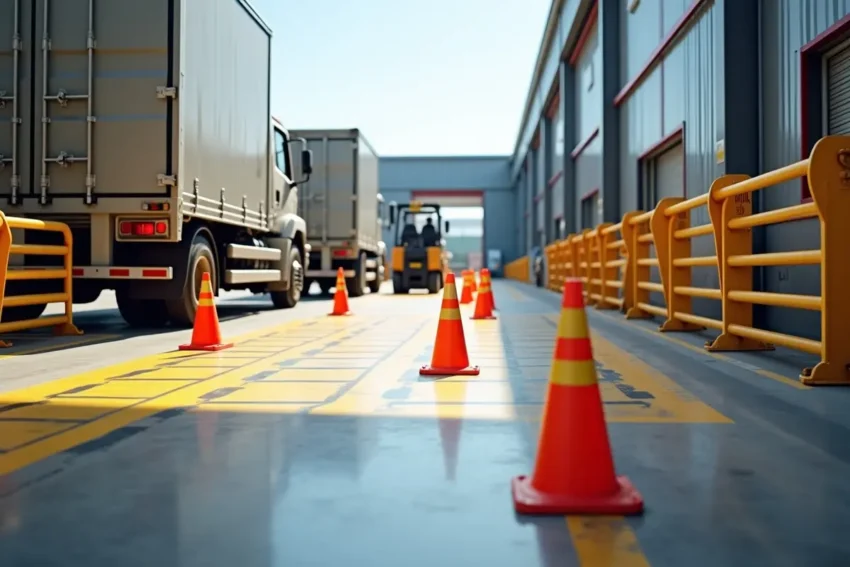How Safety Equipment Fits into Modern Commercial Loading Docks

In any commercial space, loading docks play a crucial role in the overall functionality of the building. Whether it’s for the quick and efficient movement of goods or ensuring the safety of workers, a well-designed and properly equipped loading dock can significantly impact both productivity and risk management.
Safety should always be a top priority, and integrating the right safety equipment into loading dock design is essential for minimizing hazards.
Contents
The Importance of Safety in Loading Dock Design
Loading docks are dynamic environments where vehicles, machinery, and personnel interact frequently. With the high volume of goods being handled and the constant movement of people and vehicles, accidents can occur quickly if the necessary safety precautions are not in place. The sheer amount of traffic and activity can create several safety risks, ranging from trips and falls to more severe accidents involving vehicles and heavy machinery.
As one industry expert put it, “Safety doesn’t happen by accident. Building a loading dock that incorporates the right hardware and technology can make a huge difference in mitigating risk and increasing productivity.”
This statement underscores the importance of proactive safety measures. Designing spaces with the necessary safety gear, such as barriers, dock seals, and anti-slip flooring, reduces the potential for injury and protects both employees and equipment.
The Role of Safety Equipment in Loading Docks
These are the various roles of safety equipment used when designing, building, and operating loading docks.
1. Dock Levelers and Platforms
Dock levelers are essential for creating a smooth, safe transition between trucks and the loading dock floor. They adjust the height difference between the truck and the dock to ensure a level surface for loading and unloading goods. This reduces the risk of accidents caused by uneven surfaces or workers having to step up or down from a truck.
When selecting dock levelers, it’s important to choose ones that are reliable, durable, and easy to operate. Modern dock levelers also come with features like automatic adjustment to accommodate different truck heights, further reducing manual effort and risk.
2. Loading Dock Barriers and Guardrails
Another key element of a safe loading dock is the installation of loading dock barriers and guardrails. These barriers prevent vehicles from accidentally backing off the dock and falling, thus preventing serious injuries and damage. As the Rite-Hite safety advice states, “Selecting loading dock barriers that are OSHA compliant meets walking-working surfaces regulations and helps prevent falls from elevated dock areas.”
These barriers not only provide a physical safeguard for workers, but they also help manage vehicle traffic more effectively, reducing the risk of collisions and other accidents. Ensuring that barriers are compliant with OSHA standards is an important aspect of maintaining a safe environment.
3. Anti-Slip Flooring
Slip and fall accidents are common in environments where there is a lot of foot traffic and the risk of wet or slippery surfaces. Loading docks are no exception, especially in areas where rain, snow, or spilled liquids can create dangerous conditions. Anti-slip flooring is a crucial addition to any loading dock, providing extra traction and reducing the chances of accidents.
Using materials like textured rubber mats or anti-slip coatings can provide an added layer of safety to areas prone to moisture or spills. This ensures workers can move freely and securely, even in challenging conditions.
4. Lighting and Visibility
Proper lighting in loading docks is essential for worker safety, particularly during night shifts or in poorly lit areas. Docks should be equipped with bright, well-positioned lights to improve visibility of loading areas and to help workers see potential hazards. Inadequate lighting can contribute to accidents by making it difficult for workers to spot obstacles or recognize unsafe conditions.
Moreover, visibility isn’t just about lighting. Using reflective tape on floors, walls, and equipment can also help workers better identify areas where caution is needed.
The Design Considerations of Safety
Integrating safety features into the design of a loading dock is not just about adding the right equipment—it’s also about creating a space that is ergonomically safe and minimizes the need for manual tasks. According to the Safe Design of Structures Code of Practice, “Designing spaces which accommodate or incorporate mechanical devices to reduce manual task risks ensures safer use of the structure.”
This could mean incorporating features like automated lifting equipment or conveyors to reduce the need for workers to manually move heavy goods. By reducing the amount of physical strain on employees, the chances of injury due to repetitive tasks or overexertion are significantly lowered. Furthermore, integrating these devices into the initial design can prevent clutter and ensure that safety equipment is conveniently located for easy access and use.
Meeting OSHA Standards
Compliance with OSHA standards is not just a legal requirement but an integral aspect of creating a safe working environment. The Safe Design of Structures guidelines emphasize the need for providing “sufficient space to safely install, operate and maintain plant and machinery.” This consideration ensures that equipment can be used properly and maintained safely, preventing breakdowns or accidents during operation.
The proper installation of loading dock equipment, such as safety gates, bumpers, and barriers, ensures that the structure meets all safety standards and is fully operational. OSHA-compliant equipment also ensures that the loading dock remains a safe and secure space for workers and minimizes liability for employers.
The Benefits of Choosing the Right Safety Gear
The importance of having the correct safety equipment cannot be overstated. By selecting high-quality safety gear and equipment, businesses ensure that their loading docks operate efficiently and with reduced risk. The right safety equipment also contributes to higher employee morale, as workers feel safer and more secure in their environment, leading to better productivity.
A comprehensive range of safety supplies is available to equip your business with the best solutions for a safe working environment. From personal protective equipment (PPE) like gloves, eyewear, and high-visibility vests to cleaning supplies and office essentials, having access to a complete range of products is essential for maintaining a safe space. Safety Source LLC provides an extensive selection of loading dock equipment and safety supplies, offering businesses a one-stop shop for all their safety needs.
By purchasing in bulk or wholesale, companies can save on costs while still ensuring that they have the best equipment available. Whether you need products to protect your staff or improve your loading dock’s functionality, the right safety supplies can make all the difference.
Conclusion
In conclusion, safety should always be a priority when designing and maintaining commercial loading docks. By integrating the right safety equipment—such as dock levelers, barriers, anti-slip flooring, and proper lighting—businesses can reduce accidents, ensure compliance with regulations, and improve overall efficiency.
As the industry experts and safety guidelines make clear, a well-designed loading dock that incorporates safety measures can be a game-changer, not only protecting employees but also enhancing productivity and reducing costs. Safety doesn’t happen by accident, and taking the right steps today can prevent accidents tomorrow.



